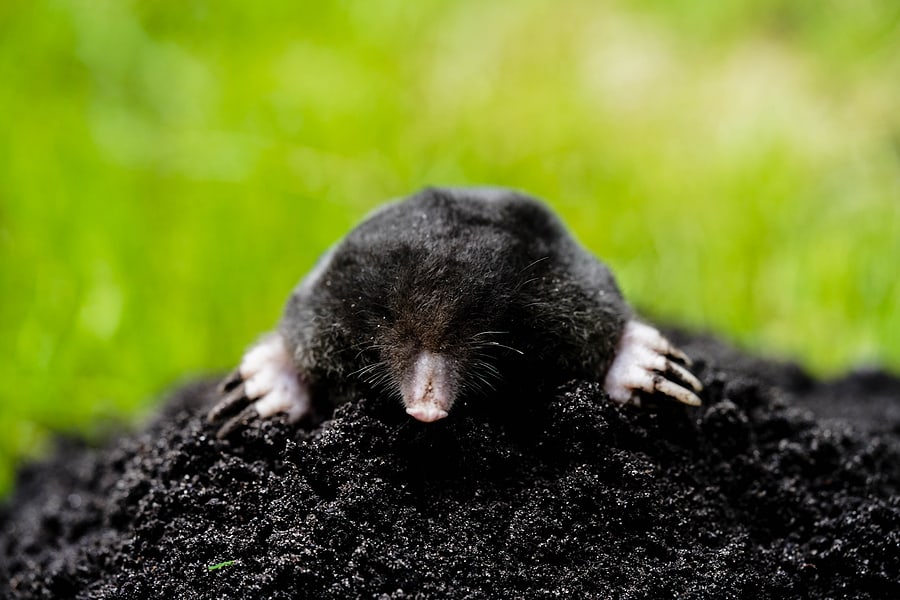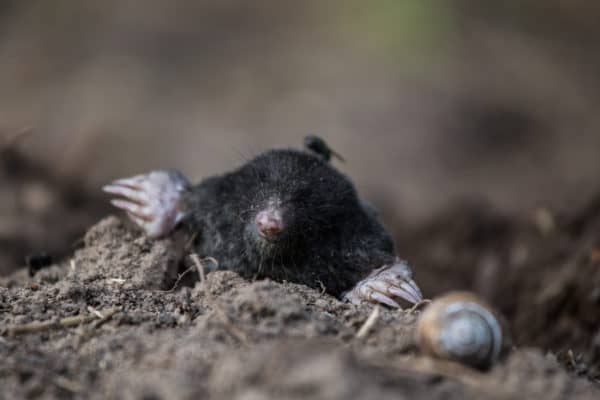READY TO GET STARTED?
REQUEST A FREE ESTIMATE
Fill out the form below or call (888) 466-7849 for a free, no-obligation estimate.

Moles can destroy your perfectly manicured lawn in a matter of days. These small, burrowing insectivores can be found in North America, Europe, and Asia. While they don’t actually eat plants and roots, their burrowing causes significant damage to both lawns and flower beds. Moles can dig up to 18 feet per hour and are most active in early morning and evening.
Moles are small in size, ranging between 4 and 11 inches in length and weighing up to 8 ounces. They are most notable for their long, thin, hairless snouts, small eyes, and lack of external ears. They are usually greyish-brown in color. Moles have large, powerful front feet with webbed toes that they use for burrowing underground while their hindfeet are narrow with slender claws. Moles are nearly blind but they make up for their lack of vision with an exceptional sense of smell.
Moles come into your yard in search of one thing – food! Their diet consists primarily of earthworms and grubs but they will eat other soil-dwelling insects, as well. Moles leave behind a trail of damage when they burrow in your yard, leaving visible trails and brown patches and holes in your lawn. Their tunnels cave in easily, leaving you at risk for injury when you step on them.
Some of the most common signs of moles in your yard are:
Because moles live underground they can be extremely difficult to prevent. The best treatment for moles is targeted elimination usually through trapping or baiting. It is also important to treat existing tunnels so new moles don’t replace the previously removed moles.
If you have a problem with moles or any other pests, contact your local pest control company who can properly assess your situation and treat it appropriately.
How to Prevent Little Black Ants
Is Green Mosquito Control Safe?

The last thing any homeowner wants is damage to their yard after all the hard work they’ve put in to get it just right. One of the most destructive pests to yards is the mole. What attracts moles to your yard? How do you get rid of them?
Moles are burrowing insectivores, feasting on a wide variety of lawn insects. They are usually about 6 to 8 inches long with gray to black velvety fur. Moles have slender, hairless snouts and small eyes and ears. They have large front feet with long claws that they use to dig through the dirt. They breed in early spring and are most active then and in the fall. Other than during mating season, moles prefer to be alone; if you have a mole problem you are usually only dealing with one.
Moles are attracted to food sources in your yard, digging through leaving behind tunnels, holes, and mounds of dirt. Moles require quite a bit of food to survive. Common signs of moles include: surface tunnels, dying grass and plants, an increase in weeds, and molehills (which are piles of dirt less than 6 inches tall and shaped like footballs or volcanoes). Moles can dig up to 18 feet per hour. As they dig they detach the roots of plants which not only allows weeds to take root but also kills the lawn, plants, and trees.
If you have a problem with moles or any other wildlife, contact your local pest control company for a comprehensive evaluation and elimination plan.
Fall Pest Control: Oriental Cockroaches

A very common misconception is that moles hibernate during the winter. This is, in fact, not true. Moles do not hibernate and are quite active during the winter months. They actually remain active all winter long, continuing to dig and eat voraciously. Moles are omnivores that prefer to feast on grubs, earthworms, and other bugs. As the soil freezes, moles move from tunneling near the surface to digging deeper in the ground. When the weather starts to warm, the moles will tunnel closer and closer to the surface as the soil thaws and becomes easier to navigate.
Moles can wreak havoc on your lawn and garden. Moles cause dead grass patches because their tunneling disrupts the root system of grass. This creates patches that often start out yellow and eventually turn a light tan color. They also push soil and grass up as they dig, creating random mole hills across your yard. While these are easy to spot in the summertime, they can often go undetected in the winter months, giving you less opportunity to identify and eliminate them early. Because of this, it is important to take precautionary measures early before the winter season sets in. Here are some steps you can take for mole prevention this winter.
Overuse of sprinklers and irrigation systems can lead to saturated, loose soil – an ideal environment for moles. This loose soil is much easier to tunnel through and is often rich with earthworms and grubs, making it a literal feast for moles. Heavy rainfall can also create these conditions so it is important to be vigilant after storms. Limit watering unless necessary.
Mulch is a very effective insulator for plants during cold weather. While we are usually inclined to go ahead and mulch before the cold weather sets in, this creates an insulated environment for moles, as well as your plants. Instead of installing mulch in early fall, try to wait until after the first frost. Hopefully by that point, moles and other pests have established themselves in a more hospitable environment than in your yard.
Physical barriers can be very effective at preventing more damage to flowerbeds and trees. These barriers can be in the form of hardware cloth liners in the bottom and sides of flowerbeds or across the top of the bed to prevent digging or wrapped around the base of trees. By preventing them from digging you can limit the damage inflicted and hopefully encourage them to move on to another yard.
Cats, snakes, and birds of prey are the most common natural predators of moles. Cats are especially notorious for pest prevention and rodent control around properties. If you don’t already have a cat, you may consider adopting one to roam your property and provide you with free pest control. Although it may be difficult, reconsider killing that snake you find on your property as they are also excellent at controlling rodent and other pest populations.
As mentioned above, moles prefer to feed on earthworms, grubs, and other insects. In fact, mole problems often arise because of underlying grub problems. Be proactive in eliminating grubs and other pests from your yard to help control mole populations, as well.
The cliche of “making a mountain out of a mole hill” isn’t far from the truth. Mole problems can manifest quickly into mole infestations and they can be extremely difficult to control and eliminate. Consider contacting a professional pest control company and setting up ongoing pest control services as these scheduled visits can help identify mole problems early and help resolve your mole issue quickly.
5 Reasons To Be Thankful for Pest Control
Things That Go Bump in Your Crawlspace
 There’s nothing like jumping in the pool on a hot summer day (well, a day that feels like summer anyways)! So that is exactly what my family and I did on Saturday. We went to my in-laws’ house and jumped right in the pool. We had just begun to cool off and enjoy the water when we noticed we weren’t alone. There was a mole in the pool!!!
There’s nothing like jumping in the pool on a hot summer day (well, a day that feels like summer anyways)! So that is exactly what my family and I did on Saturday. We went to my in-laws’ house and jumped right in the pool. We had just begun to cool off and enjoy the water when we noticed we weren’t alone. There was a mole in the pool!!!
The mole was quickly removed without incident and the fun continued but of course my mother-in-law had lots of questions about what it was doing in her yard, how did it get there, what is was looking for, and how does she get rid of them. So mother in law…this is for you!
Moles are mammals that live underground and occasionally come to the surface. Above ground, they breathe in oxygen and are able to re-use it to survive in low-oxygen environments such as underground burrows. When they surface, they cause damage. Mole damage is divided into two types: burrows and mounds. Burrows occur when moles search for food near the surface, causing soil to be raised in ridges. Mounds are created when moles burrow deep or tunnel under solid objects such as tree roots or sidewalks and push the soil to the surface.
Moles’ bodies and front claws are ideal for digging. Their hands are quite large for their bodies and include an extra thumb and multiple joints in other fingers. There are situations where mole damage is mostly visual, but in other situations they can destroy root systems in your yard, eventually killing the grass.
Damage caused by moles:
The best way to get rid of a mole is by trapping or baiting the runs. The trick to mole extermination is to find the feeding tunnels vs. the travel tunnels. A professional animal removal service provider can distinguish between the two and can humanely remove the moles from your yard. Call Northwest Exterminating for mole removal.
What is the craziest thing you ever jumped in next to?
 There’s nothing like jumping in the pool on a hot summer day (well, a day that feels like summer anyways)! So that is exactly what my family and I did on Saturday. We went to my in-laws’ house and jumped right in the pool. We had just begun to cool off and enjoy the water when we noticed we weren’t alone. There was a mole in the pool!!!
There’s nothing like jumping in the pool on a hot summer day (well, a day that feels like summer anyways)! So that is exactly what my family and I did on Saturday. We went to my in-laws’ house and jumped right in the pool. We had just begun to cool off and enjoy the water when we noticed we weren’t alone. There was a mole in the pool!!!
The mole was quickly removed without incident and the fun continued but of course my mother-in-law had lots of questions about what it was doing in her yard, how did it get there, what is was looking for, and how does she get rid of them. So mother in law…this is for you!
Moles are mammals that live underground and occasionally come to the surface. Above ground, they breathe in oxygen and are able to re-use it to survive in low-oxygen environments such as underground burrows. When they surface, they cause damage. Mole damage is divided into two types: burrows and mounds. Burrows occur when moles search for food near the surface, causing soil to be raised in ridges. Mounds are created when moles burrow deep or tunnel under solid objects such as tree roots or sidewalks and push the soil to the surface.
The best way to get rid of a mole is by trapping or baiting the runs. The trick to mole extermination is to find the feeding tunnels vs. the travel tunnels. A professional animal removal service provider can distinguish between the two and can humanely remove the moles from your yard. Call Northwest Exterminating for mole removal.
What is the craziest thing you ever jumped in next to?